Travel
Understanding the world of cathedrals: Cathedral of our Lady in Strasbourg (France)
*This is Part 2.
About the workers and finances:
The cathedral of Strasbourg was financed mostly by the bourgeois. There was more money given than in any other cathedrals built in Germany. Almost no indulgence money was used in Strasbourg except for the nave in 1253.
The citizen participated too in the funding. But sometimes money was lacking to do everything as planned.
We found the book of spending and know that the master architect had the best salary of the entire town of Strasbourg. He had an annual salary paid in 4 times, paid no matter what. In addition the architect would receive a weekly salary, but this was not always paid.
The workers had helpers called “valets”. They received as payment in addition to money wine, sauerkraut, bread and wood. They had a social insurance, meaning money was put aside weekly in case they became sick.
Lots of people worked on the cathedral in 1419, about 156. We know that some of the workers came from Cologne and Chartres, where they had worked on the cathedral there.
There was a guide of rules to obey: 15 rules for apprentice and 34 articles relating on the masters and companions.
Important bishops, artists and architects:
- Bishop Werner von Habsburg (1001-1028): in the 11th century he started the cathedral after the fire which destroyed the Romanesque
basilica. - Heinrich von Hasenburg: bishop, who started to reconstruct after the 1176 fire.
- Erwin von Steinbach was from Mainz. Erwin did not have much money.
He was there until 1318. Many of his children worked in the cathedral
as well. It is his son John who took over and supervised until 1339.
During his time, the tower was not finished, only the Great rose window.
In 1316 Erwin finished the Blessing chapel. - Architect Gerlach (grandson of Erwin von Steinbach): worked on the Northern tower
- Ulrich von Ensingen from Ulm: worked on the tower and rose – done 1399
- Geiler of Kaysersberg: preacher at the cathedral. He gave lively speeches for more than 30 years from 1478.
Difficult times:
As previously mentioned, the cathedral outlived difficult times during the long building process and after. It is unbelievable it is still standing today.
We know about the fires of 873, 1002, 1007, 1140, 1150, 1176, 1298, 1394, 1540, 1555, 1568 1624, 1625 and 1759. The archives burnt down during the fire of 873.
There was the Great Plague of 1349. Earthquakes (1279, 1289, 1291) were common during the Middle Ages.
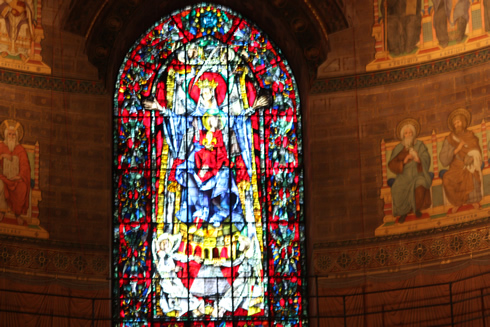
Blessing Virgin window, Strasbourg cathedral
The spire had to be rebuilt in 1654 after being struck by lightning.
The French Revolution, the war of 1870 and the Second World War were all difficult times. The cathedral survived.
It was hard during the War of 1870 especially during the night of the
25-26th of August. The organ was hit and repaired later. During WWII
while one house out of three in Strasbourg was destroyed, the cathedral
was never bombed. One says that the body of the cathedral was diverting
the bombs’ trajectory.
What you should not miss:
- Choir: beautiful when lit up – completely renovated early
2000’s. It was built in 1015. In 1240 a choir screen was built but it
was lost during Louis the 14th. - Facade: the Western facade is breathtaking. Look at the St.
Lawrence portal showing its martyrdom. As well a “harp strings”
decoration - Nave: 206 feet (63 meters) long by 101 feet (31 meters) high.
The building was rapid from 1241-1275. It is magnificent with 7 large
pillars on each side. Pulpit: where Geiler of Kaysersberg used to preach. Gothic
Flamboyant designed by Hans Hammer and built from 1485-87. Notice the
dog at Geiler’s feet and the fifty small sculptures.
- Rose: Erwin von Steinbach’s work over the central facade. It is 49 feet (15 meters) in diameter.
- Spire: one single one of 150 feet (46 meters).Stain glass windows: most of them are original from the Gothic era.
- Tapestries: probably from the 17th century and shown only during Easter and Christmas holidays.
- Northern Tower: unique tower of 328 feet (100 meters) height, started in 1276 and finished in 1439 with Ulrich von Ensingen.
Tapestries
Something new for me this time while visiting the cathedral, I was able to take a look at the 14 tapestries hanging on both side of the nave.
When our guide started working at the cathedral she said non one cared about them; people even walked on them. Luckily 15 years ago an art historian researched them and got interested in them. They were since restored and one knows how valuable they are. For this reason to preserve them they are only shown to the public for special occasions
and during Christmas holidays.
There are a total of 14 tapestries by Phillip de Champaigne, Jacques Stella and Pierre Damour. Restoration took place in 1999.
One of the 14 tapestries hanging in the Cathedral of our Lady
But what is known about these tapestries?
King Louis the 13th, so happy at the birth of his son, Louis XIV asked the cardinal of Richelieu to have done some tapestries for the cathedral of Strasbourg. Four of them were done in Belgium in Brussels.
Later the archbishop, Armand Gaston, the illegitimate son of Louis XIV, acquired the tapestries to hang in his palace, the Palais Rohan. The tapestries were left there until the Revolution. They were moved and everyone forgot about them!
Stain glass windows:
The Cathedral of our Lady has magnificent stain glass windows counting numerous legends and bible stories. They are all from the 12th, 13th or 14th century apart from the Great rose window, which is a copy from the 19th century.
The 13th century crucifixion stain glass window (H 213 Feet/65 cm by L150 feet/46 cm) is stored at the museum of the cathedral.
Many windows are the works of John Markgraf, James Vischer, John Danegger, Joseph Heim, Link Brothers and John Kirchheim.
Luckily nothing happened to the stain glass windows during the end of WWI in 1918. During WWII, in 1939 they were put in boxes and sent to the region of Dordogne. Two years later in 1941 the Germans hide them and put them in the salt mines of Stuttgart in Heilbronn (Baden Württemberg). At the end of the war in 1945 the Americans found them and brought them back a decade later.
In October 1956 the council of Europe gave the cathedral the window called the Blessing Virgin.
Stones:
The stones used to build the cathedral comes from the Vosges mountains in Eastern France and from the Black Forest in Germany. The color of the stones is of pink color called Grès, also Sandstein in German.
This stone is a tender and warm sandstone, which reacts to the light. What one sees when visiting the cathedral depends on the luminosity. Some day, the cathedral appears dark while at some other moment it may look happy and radiant.
Crib/nativity scenes:
During the Christmas season, it is possible to enjoy the crib bought in 1908. At the Strasbourg cathedral, one shows elements of temples rarely shown in a crib. As well the baby Jesus is put in the the crib right away. One does not wait Christmas Eve. Normally it was put at midnight, but to help the children understand better the story of Jesus,
the baby is brought directly there.
Today’s renovations:
Many renovations have been done in the cathedral. In 2004 the choir was redone under the architects, Jean-Marie Duthilleul and Benoit Ferre. It had been discussed to put some mosaics in the choir but one did not. Since its construction in the 11th century there had been much changes done.
Some important numbers and facts to remember:
- construction started in 1015
- finished in 1439
- spire is at 465 feet (142 meters)
- it was the first tallest building in the world from 1625 until 1847
- tallest church until 1880
- today: 6th tallest church in the world
- Strasbourg is not on the Rhine river but on the Ill river
- the clergy is paid by the state in Strasbourg, at the same level as the Brigadier General.
- the Concordat of 1801 from Napoleon is still working.
I am quite sure this was not my last visit to the Cathedral of our Lady.

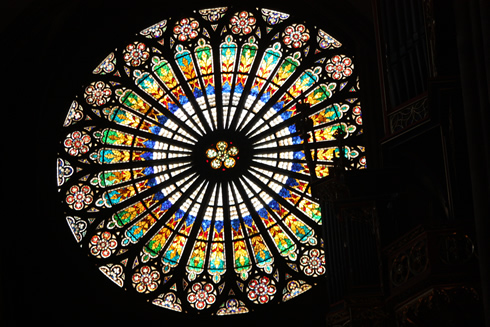
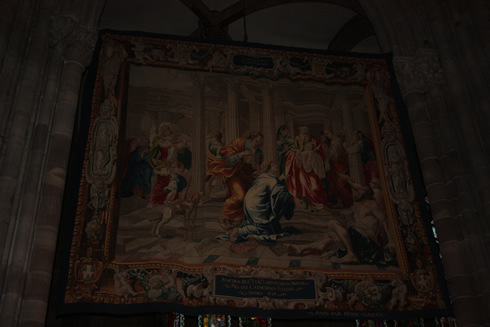
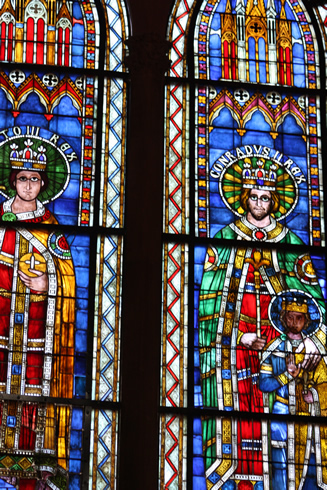
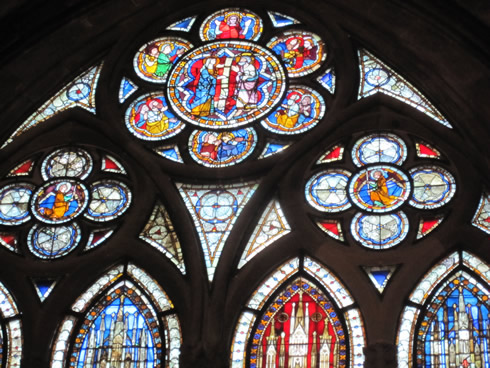
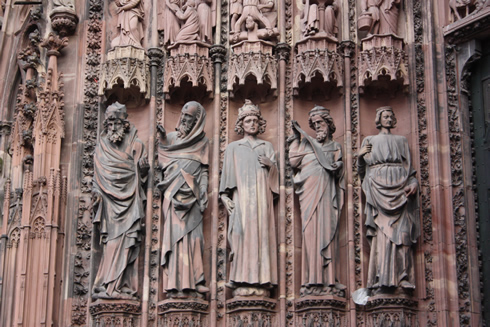
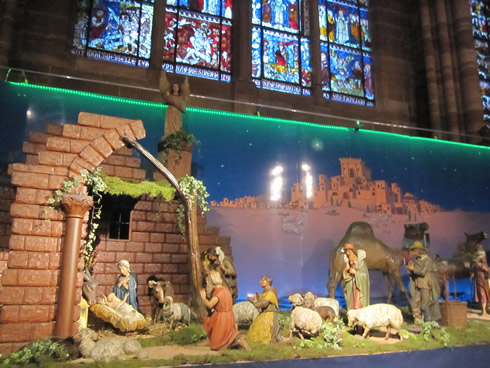
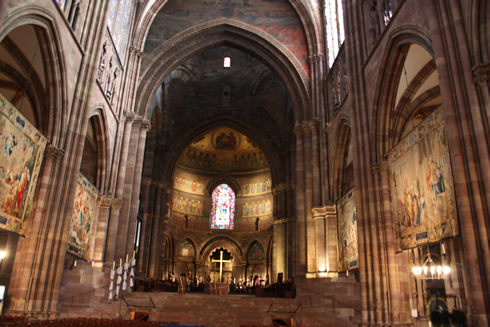

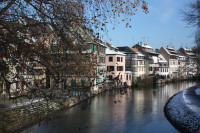
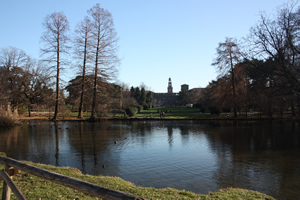

Great blog. Thanks.